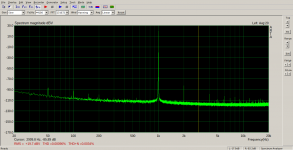Vishay Beyschlag CPF series metal thin film 2% 200ppm 0.22R 3W will be available in Jan 2020 from Mouser (500 are on order).
CPF3R22000GNB14 Vishay / Dale | Mouser
https://www.mouser.com/datasheet/2/427/cpf-64917.pdf
But if we can go with 2W, Panasonic ERX, 5000 are in stock:
ERX-2FJSR22E Panasonic | Mouser
This might work as the dissipation there is only 600mW (DC load) from the sims.
Still listening and have not done a direct A/B comparison with the Alpha BB yet - but what I am hearing is very very good. The stereo separation is excellent for a non-monoblock amp. Great imaging and sound stage. I am listening to Deep Forest's "Rid of Me" and "Sunrise at Alcatraz" which really test the stereo imaging and left/right pan very well. The sound quality in terms of bass impact, mid range clarity, and resolving highs are all there of course. Also, the requisite "foot tapping" dynamics that your amps are known for, are there in spades. I think your trick of boosting the low frequency damping factor must be doing good things. 🙂
CPF3R22000GNB14 Vishay / Dale | Mouser
https://www.mouser.com/datasheet/2/427/cpf-64917.pdf
But if we can go with 2W, Panasonic ERX, 5000 are in stock:
ERX-2FJSR22E Panasonic | Mouser
This might work as the dissipation there is only 600mW (DC load) from the sims.
Any thoughts on the sound compared to the Alpha 20 and the BB?
Still listening and have not done a direct A/B comparison with the Alpha BB yet - but what I am hearing is very very good. The stereo separation is excellent for a non-monoblock amp. Great imaging and sound stage. I am listening to Deep Forest's "Rid of Me" and "Sunrise at Alcatraz" which really test the stereo imaging and left/right pan very well. The sound quality in terms of bass impact, mid range clarity, and resolving highs are all there of course. Also, the requisite "foot tapping" dynamics that your amps are known for, are there in spades. I think your trick of boosting the low frequency damping factor must be doing good things. 🙂
Last edited:
Thanks X,
It's half midnight here, I really need to sleep. But tomorrow is another day.....
I am pleased that the finer areas we strive for are all there. We are doing something good!
One thing I'm interested in is the PSRR. With a CRCRCRC, no SLB, I wonder if is as quiet. I suspect not.........
Hugh
It's half midnight here, I really need to sleep. But tomorrow is another day.....
I am pleased that the finer areas we strive for are all there. We are doing something good!
One thing I'm interested in is the PSRR. With a CRCRCRC, no SLB, I wonder if is as quiet. I suspect not.........
Hugh
The cost of the 8 bulk caps (per channel), active bridge parts (4 LT4220 bridges), etc. will cost as much as an SLB, if not more. But is certainly simpler. I recall the PSRR on the Omega which also used the same CRCRCRC PSU was pretty quiet, so you are probably ok. Those huge 3W 0.15R thin film SMT resistors you use are not cheap, but I guess you have a stockpile already.
Get some rest Hugh! Sleep well knowing that this amp is all good!
Get some rest Hugh! Sleep well knowing that this amp is all good!
Next evolution or new amp maybe a Nirvana class A+AB. First 10 watts? at class A, with 40% efficiency -> less heat. 🙂
* At 8 Ohms: max 60-80 watts in class AB.
* At 4 Ohms: more than 100 watts in class AB.
And do not wrinkle with difficult and complex loads.
BTW, congratulations to ALL those involved in its design.
* At 8 Ohms: max 60-80 watts in class AB.
* At 4 Ohms: more than 100 watts in class AB.
And do not wrinkle with difficult and complex loads.
BTW, congratulations to ALL those involved in its design.
Hi Maty,
Perhaps the Alpha Nirvana can now drive your beloved 5ohm KEF's? Probably a boost in bias current is all it takes.
Perhaps the Alpha Nirvana can now drive your beloved 5ohm KEF's? Probably a boost in bias current is all it takes.
It is what I always think. Now I am in the middle of an audiophile improvement? of the crossover. With Mills resistors 5 watts.
Weeks ago it was estimated by kokoriantz -thank you very much- that Nirvana at 4 Ohms would also be 39 watts at THD 0.1%, while I want a minimum of 100 watts at 4 Ohms, or 80 watts at 5 Ohms. Three days ago, a very great 24/192 FLAC vinyl rip with DR17. With a track of DR20.
Rimsky-Korsakov, Turina, Debussy - Eduardo Mata And Dallas Symphony Orchestra - Iberia / Capriccio Espagnol, Op.34 / Orgia (1981, Vinyl)
PS: The desire of a class D is being taken away from me after the latest PMA contributions about Hypex nCore modules.
Weeks ago it was estimated by kokoriantz -thank you very much- that Nirvana at 4 Ohms would also be 39 watts at THD 0.1%, while I want a minimum of 100 watts at 4 Ohms, or 80 watts at 5 Ohms. Three days ago, a very great 24/192 FLAC vinyl rip with DR17. With a track of DR20.
Rimsky-Korsakov, Turina, Debussy - Eduardo Mata And Dallas Symphony Orchestra - Iberia / Capriccio Espagnol, Op.34 / Orgia (1981, Vinyl)
PS: The desire of a class D is being taken away from me after the latest PMA contributions about Hypex nCore modules.
Last edited:
I was pretty happy with the performance of the TPA3255 that I made with JPS64’s help. It provides a solid 100w for sure at fairly low THD. My implementation has dominant second order second order harmonic distortion. If I had to use a Class D amp, this would be it.
TPA3255 Reference Design Class D Amp GB
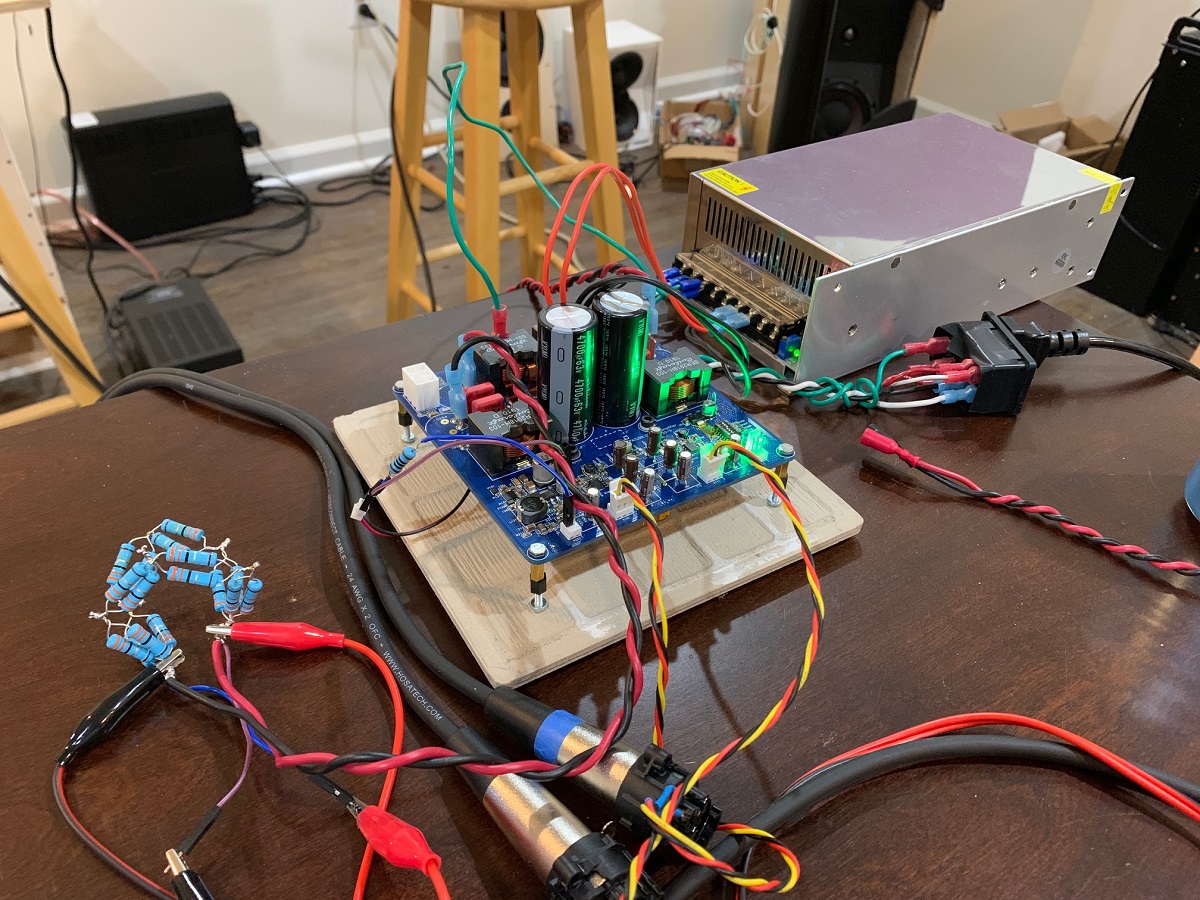
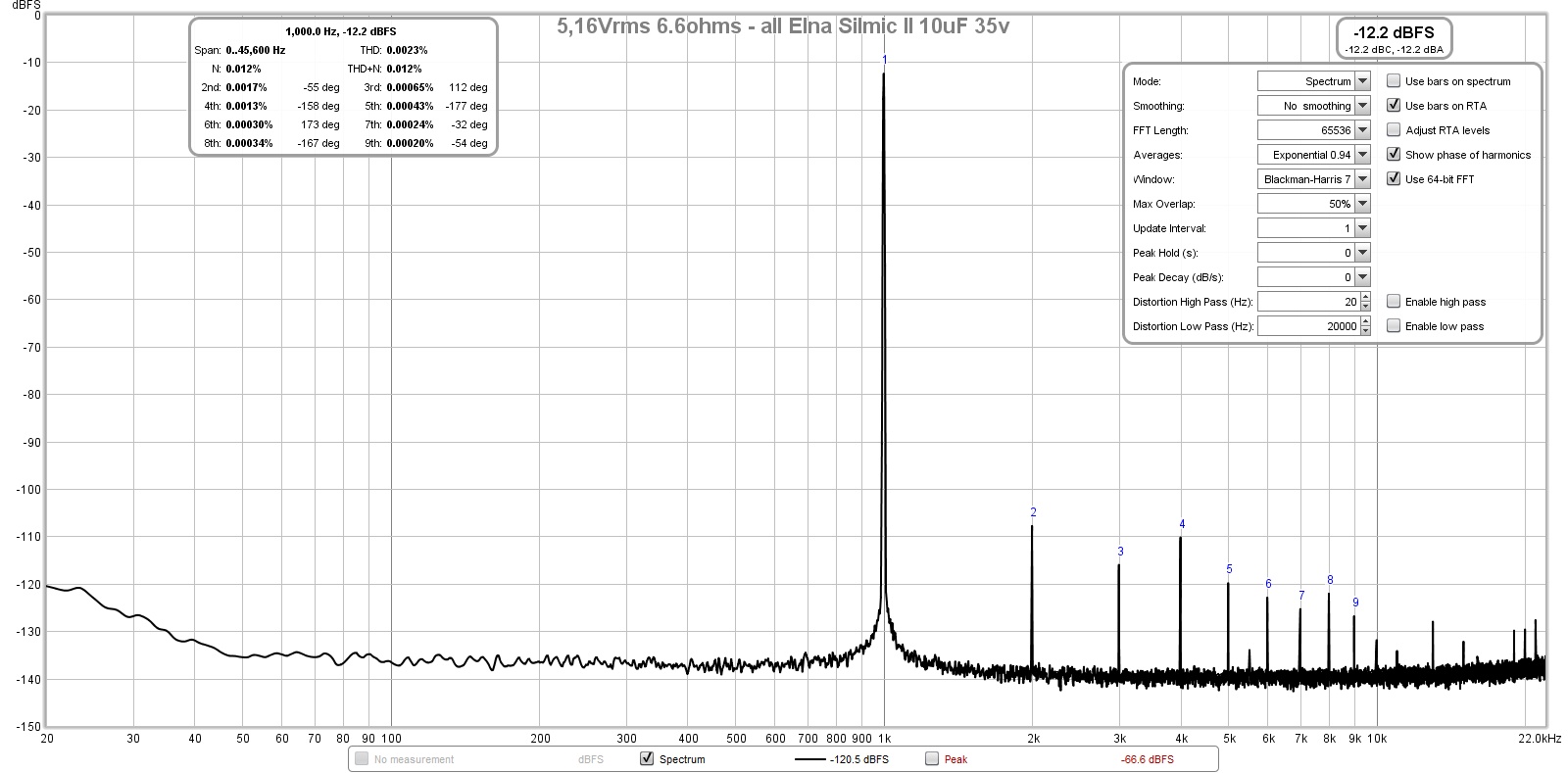
TPA3255 Reference Design Class D Amp GB
I follow your development closely. Disadvantage: some complicated welding I think.
I just thought about you, after commenting on the last vinyl I am listening to. I do not know why 😀

I just thought about you, after commenting on the last vinyl I am listening to. I do not know why 😀

Measurements are excellent, THD is certainly beyond the hearing capabilities of any "golden" ears. I had expected they would outperorm my lateral MOSFET amp driven in class AB (100mA bias) - but this is not the case. So personnally I do not see the point in excessive heat dissipating class-A designs.
For comparison I append a THD FFT measurement with 10Vrms into 5Ohms at 1kHz.
btw hum seems to be in the same region
For comparison I append a THD FFT measurement with 10Vrms into 5Ohms at 1kHz.
btw hum seems to be in the same region
Attachments
Last edited:
Measurements are excellent, THD is certainly beyond the hearing capabilities of any "golden" ears...
In my two audio systems I can differentiate easy between MP3 LAME 320kbps vs FLAC 16/44. And 16/44 vs 24/96 and 24/192 from many years ago. In other systems, much more expensive, I have been unable. Probably because I have been eliminating and / or minimizing the bottlenecks I had. Many still believe that money solves problems in audio but ...
And delays too. 4 ms from 4.2 ms for example. In my second system, with my beloved little coaxials.
- End of topic -
Measurements are excellent, THD is certainly beyond the hearing capabilities of any "golden" ears. I had expected they would outperorm my lateral MOSFET amp driven in class AB (100mA bias) - but this is not the case. So personnally I do not see the point in excessive heat dissipating class-A designs.
For comparison I append a THD FFT measurement with 10Vrms into 5Ohms at 1kHz.
btw hum seems to be in the same region
I agree that many Class AB amps will have better THD performance measurements. But if that was all there was to good sounding amps, we would all just be listening to ultra-low distortion Class AB chip amps, and hot-running Class A amps would be relegated to museums. 🙂
Maty,
I fully agree with X on this, and indeed on most things! There seems to be some characteristic sound with a Class A, a seamless, natural, surreal presentation which no AB appears unable to duplicate.
I have been trying for twenty five years to make an AB sound like an A, I admit I have come close, but whilst many are very good amplifiers, they are subtly different to like a Class A. Once heard it is hard to go back.......
Hugh
I fully agree with X on this, and indeed on most things! There seems to be some characteristic sound with a Class A, a seamless, natural, surreal presentation which no AB appears unable to duplicate.
I have been trying for twenty five years to make an AB sound like an A, I admit I have come close, but whilst many are very good amplifiers, they are subtly different to like a Class A. Once heard it is hard to go back.......
Hugh
Last edited:
XRK,
How do you have the transformer mounted in your latest Alpha Nirvana pic? Is it mounted to the front panel?
Best,
Anand.
How do you have the transformer mounted in your latest Alpha Nirvana pic? Is it mounted to the front panel?
Best,
Anand.
No backing up by any measurements - just subjective opinions - no evidence by double blind tests. Following this argumentation, the measurements presented above are without any meaning. Ok, I am done here.Maty,
I fully agree with X on this, and indeed on most things! There seems to be some characteristic sound with a Class A, a seamless, natural, surreal presentation which no AB appears unable to duplicate.
I have been trying for twenty five years to make an AB sound like an A, I admit I have come close, but whilst many are very good amplifiers, they are subtly different to like a Class A. Once heard it is hard to go back.......
Hugh
Last edited:
Ok, I am done here.
Very wise decision voltwide....let the guys do their business here 🙄
No backing up by any measurements - just subjective opinions - no evidence by double blind tests. Following this argumentation, the measurements presented above are without any meaning. Ok, I am done here.
I am all about measurements too - I probably post more measurements than anyone on DIYA, whether it be speakers or amps. However, there is a difference in Class A. My TPA3255 is superior in measured performance in every way. But it doesn’t sound as smooth or natural. It’s close to a good Class A amp but it is not quite the same. As Hugh said, it is subtle. I can pick it out in blind test.
That’s fine that you are done here - but have you tried listening to a SE Class A amp with low to zero feedback before? There’s something about it - besides just the dominant second order harmonic distortion. We can hear frequency to 20kHz but our ears hear phase information as fast as 300kHz. Amps that don’t mess with this phase info seem to convey spatial imaging info very well.
If you don’t think people can hear the difference - check out my thread where I compared headphone amps - sound from a load resistor digitized and recorded. Level matched to same value for different amps. Guess which one won in a blind test? The SE Class A with zero global feedback.
Thank you for your advice. I hooked up my 10R 300w ultralow inductance dummy test load and then connected my Focusrite 2i4 to it with 10:1 balanced voltage divider (AC coupled via a pair of 1uF Wima MKS caps). Turned on REW in RTA mode and looked at the noise background FFT like a stethescope to do real-time grounding checks.
So I found that it helped to connect the return for the speaker back to the amp PCB as you suggested. This dropped the 60Hz mains peak by about 20dB - significant. But it is not zero. I also disconnected the funky gnd from the RCA -ve to the 0v hub. That helped by about another 5dB. The biggest difference was just moving the AC wire bundles around to tiy them up and keep them tightly coiled near the trafo. In fact, I stuffed the excess AC wires into the donut hole of the trafo and taped them shut with a piece of Kapton tape. That reduced a lot of the HF mains hash that I was seeing. I also added a ground wire from the SLB heatsink to the chassis ground. I added dediccated ground wires from each heatsink to the chassis gorund point. I think the remaining 60Hz peak and higher order mains harmonics are probably from EMI radiated from the trafo itself being in close proximity of the boards.
The amp now looks like this:
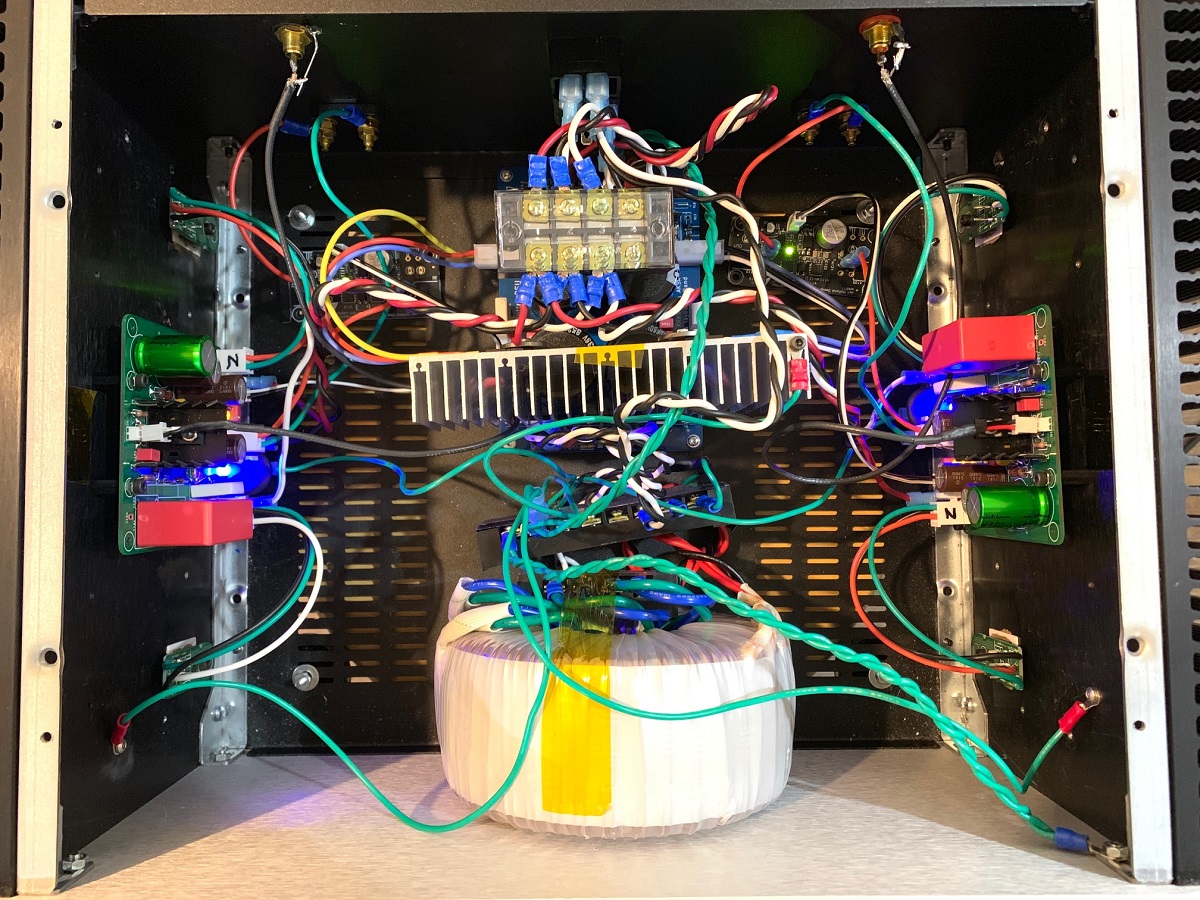
Here is the new grounding diagram v2:
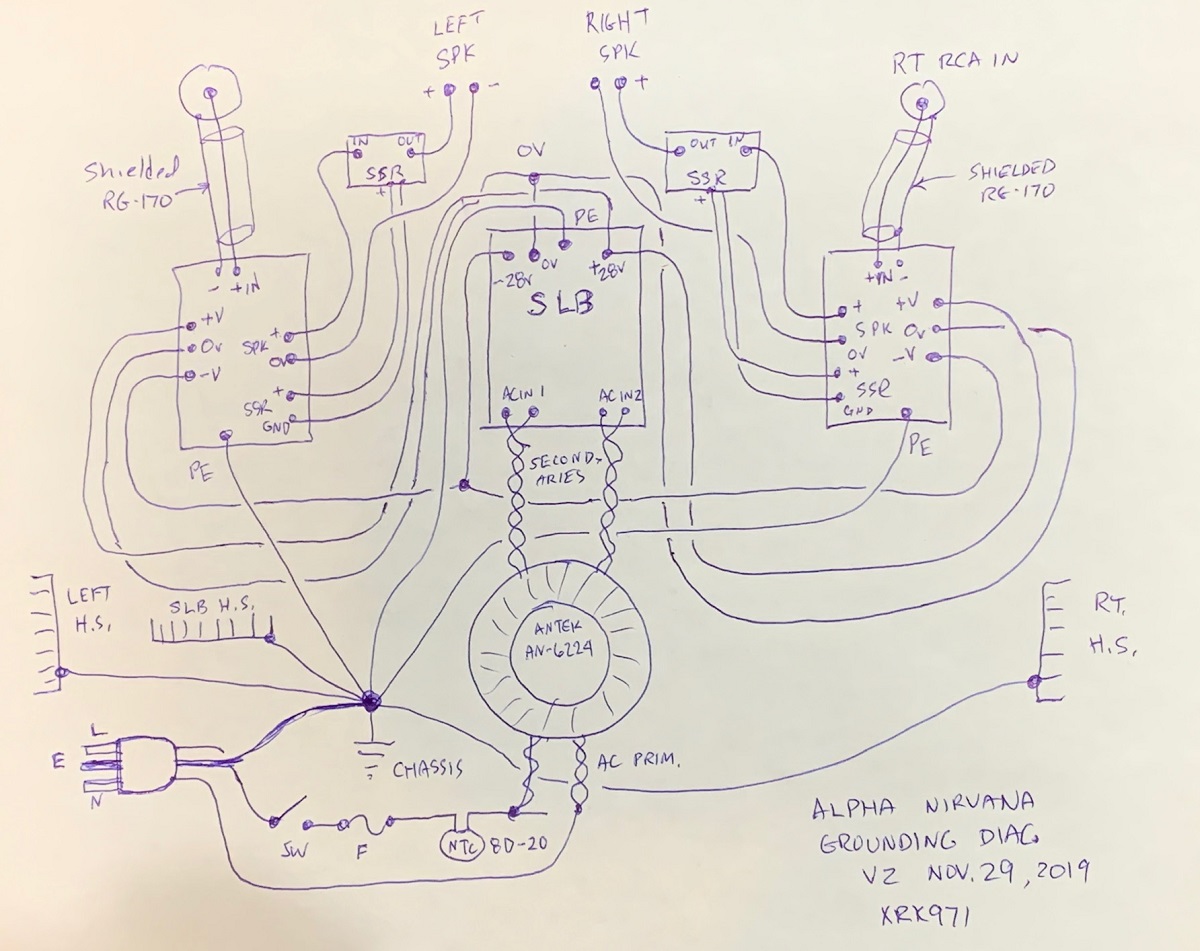
And here is the resulting background noise FFT for the Alpha Nirvana as connected above. With my ears pressed to the speaker cone, there is no noise. It is a very quiet amp now. The Fluke 101 measures 0.1mV rms noise with the sound source turned to zero volume.
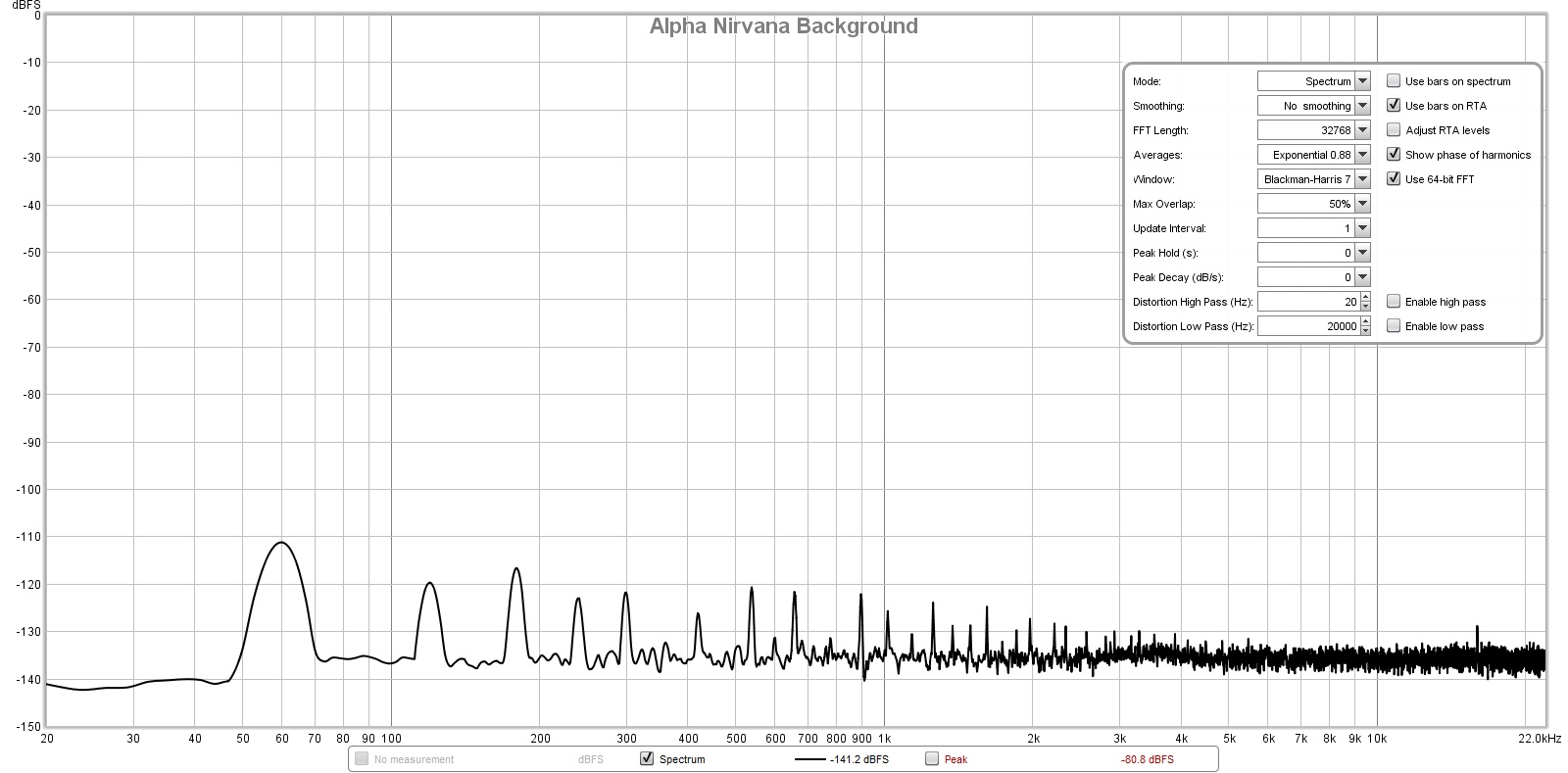
Awesome very glad to be of some help! 🙂
0,22 Ohm
I am still following, with interest, by reading the progress with this "NEW" Alpha.
So i read about the 0,22 Ohm/3W resistors.
My search showed this:
https://www.mouser.de/Passive-Compo...gh-Hole-Resistors/_/N-7h7z5?P=1z0wszxZ1z0vij7
The Vishay is also available in 3W:
CPF3R22000GNB14 Vishay / Dale | Mouser Deutschland
And i found too a more expensive version, don't know about quality, this ones:
https://www.mouser.de/Passive-Compo...le/_/N-7fx9i?P=1z0wszx&Keyword=71-LVR&FS=True
Hope this helps to shoos select parts right now.
Regards.
I am still following, with interest, by reading the progress with this "NEW" Alpha.
So i read about the 0,22 Ohm/3W resistors.
My search showed this:
https://www.mouser.de/Passive-Compo...gh-Hole-Resistors/_/N-7h7z5?P=1z0wszxZ1z0vij7
The Vishay is also available in 3W:
CPF3R22000GNB14 Vishay / Dale | Mouser Deutschland
And i found too a more expensive version, don't know about quality, this ones:
https://www.mouser.de/Passive-Compo...le/_/N-7fx9i?P=1z0wszx&Keyword=71-LVR&FS=True
Hope this helps to shoos select parts right now.
Regards.
Hi BanglaH,
Thanks for looking that up. The Vishay metal thin film is good and same as CPF one I mentioned earlier. The first one you linked cannot be used. I have tried those before and they are wirewound and wirewound must strictly be avoided as source resistors. They add huge amounts of distortion. You are better off with metal oxide thick film if it came to choosing wirewound.
Carbon composition can work here too. 3W Carbon comp might be expensive and big.
Thanks for looking that up. The Vishay metal thin film is good and same as CPF one I mentioned earlier. The first one you linked cannot be used. I have tried those before and they are wirewound and wirewound must strictly be avoided as source resistors. They add huge amounts of distortion. You are better off with metal oxide thick film if it came to choosing wirewound.
Carbon composition can work here too. 3W Carbon comp might be expensive and big.
- Home
- Amplifiers
- Solid State
- Alpha Nirvana 39w 8ohm Class A Amp
